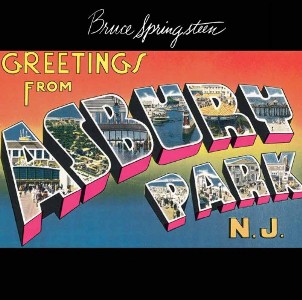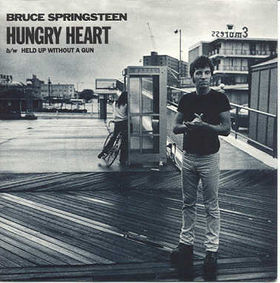
Bruce Frederick Joseph Springsteen is an American rock singer, songwriter, and guitarist. Nicknamed "the Boss", he has released 21 studio albums during a career spanning six decades, most of which feature his backing band, the E Street Band. Springsteen is a pioneer of heartland rock, a genre combining mainstream rock music with poetic and socially conscious lyrics that feature narratives primarily concerning working class American life. He is known for his descriptive lyrics and energetic concerts, which sometimes last over four hours.

Greetings from Asbury Park, N.J. is the debut studio album by the American singer-songwriter Bruce Springsteen. It was produced from June through October 1972 by Mike Appel and Jim Cretecos at the budget-priced 914 Sound Studios. The album was released January 5, 1973, by Columbia Records to average sales but a positive critical reception.

Born to Run is the third studio album by the American singer-songwriter Bruce Springsteen. It was released on August 25, 1975, by Columbia Records. Co-produced by Springsteen, his manager Mike Appel, and Jon Landau, the album was Springsteen's effort to break into the mainstream following the commercial disappointment of his first two albums. Springsteen's perfectionism led to arduous sessions with the E Street Band; recording sessions lasted from January 1974 to July 1975 in New York City, and six months were spent on the song "Born to Run" alone. Early radio play of "Born to Run" generated anticipation towards the album's release.

"Blinded by the Light" is a song written and recorded by Bruce Springsteen, which first appeared on his 1973 debut album Greetings from Asbury Park, N.J. A cover by British rock band Manfred Mann's Earth Band reached number one on the Billboard Hot 100 in the United States in February 1977 and was also a top ten hit in the United Kingdom, New Zealand, and Canada.

"Tenth Avenue Freeze-Out" is a song by the American singer-songwriter Bruce Springsteen, from his 1975 album Born to Run.
"Growin' Up" is a song by American musician Bruce Springsteen from his 1973 album Greetings from Asbury Park, N.J..

"Hungry Heart" is a ballad written and performed by Bruce Springsteen on his fifth album, The River. It was released as the album's lead single in 1980 and became Springsteen's first big hit on the Billboard Hot 100 chart peaking at number five.

"My Hometown" is a single by Bruce Springsteen off his Born in the U.S.A. album, that was the then-record-tying seventh and last top 10 single to come from it, peaking at #6 on the Billboard Hot 100 singles chart. It also topped the U.S. adult contemporary chart, making the song Springsteen's only #1 song on this chart to date. The song is a synthesizer-based, low-tempo number that features Springsteen on vocals.

"Prove It All Night" is a song by the American singer-songwriter Bruce Springsteen, released on May 23, 1978, as the first single from his fourth studio album Darkness on the Edge of Town.
"Ramrod" is a song written and performed by Bruce Springsteen for his fifth album, The River, released in 1980. It was recorded at The Power Station in New York on June 12, 1979. The song was written and originally recorded on September 12, 1977, for Springsteen's Darkness on the Edge of Town album, but that recording was not used for its release on The River.
"Be True" is a song by Bruce Springsteen. It was recorded on July 18, 1979 at The Power Station in New York in one of the early recording sessions for Bruce Springsteen's album The River. It was not released on the album, but in 1981 it was released as the B-side to the single release of "Fade Away", a song taken from The River album. According to Springsteen, "Be True" was left off The River album in favor of the song "Crush on You", a decision he has a hard time understanding in retrospect. Springsteen was already second guessing his decision to exclude "Be True" from The River before the album was even released.

"One Step Up" is a song by Bruce Springsteen from his eighth studio album, Tunnel of Love (1987). It was released as the third single from the album, following "Brilliant Disguise" and the title track. It reached position #13 on the Billboard Hot 100 chart, #3 on the Adult Contemporary chart in the United States, and #23 in Canada. It also reached #2 on the U.S. Album Rock Tracks chart, giving Springsteen three straight top two tracks from the album. The song was only released as a single in America. One of the unreleased songs from 1980's The River, "Roulette", recorded April 3, 1979, was released as the b-side, using an alternate vocal mixed on April 12, 1980, that would also be used in 1998, when it was chosen for Tracks.
"It's Hard to Be a Saint in the City" is a song written and performed by Bruce Springsteen on his debut album Greetings from Asbury Park, N.J. in 1973. The song talks about a young man growing up on the streets of a city trying to stay good and do what he believes is right. It has been covered by David Bowie. John Sayles included this song in a high school lunchroom scene of his movie Baby It's You.
"Mary Queen of Arkansas" is a song by Bruce Springsteen from the album Greetings from Asbury Park, N.J., released in 1973. Springsteen played "Mary Queen of Arkansas" at his audition for John H. Hammond at CBS Records, who signed him to his first record contract on May 2, 1972, although Hammond was less impressed with this song than with "It's Hard to Be a Saint in the City" or with "Growin' Up". The day after signing the contract, Springsteen recorded "Mary Queen of Arkansas" as part of a 12-song demo for Hammond. The demo version of the song was released on Tracks in 1998.
"Does This Bus Stop at 82nd Street?" is a song by Bruce Springsteen from the album Greetings from Asbury Park, N.J., released in 1973. The song was part of the demo that Springsteen recorded for John Hammond of CBS Records in advance of getting his first recording contract. This demo version was released on Tracks in 1998.
"Lost in the Flood" is a song by Bruce Springsteen. It was released on his debut album, Greetings from Asbury Park, N.J. in 1973.
"The Angel" is a song by Bruce Springsteen from the album Greetings from Asbury Park, N.J. in 1973. It was also released as the B-side to Springsteen's "Blinded by the Light" single. The song was part of the demo that Springsteen recorded for John Hammond of CBS Records in advance of getting his first recording contract. At the time Greetings from Asbury Park, N.J. was released, Springsteen considered it his most sophisticated song. It has had very few live performances.
"For You" is a song written and recorded by Bruce Springsteen in 1972 for his debut album Greetings from Asbury Park, N.J., released in 1973. It was later included on the compilation album The Essential Bruce Springsteen. The song has been covered by Manfred Mann's Earth Band, The Format, and Greg Kihn.

"Cadillac Ranch" is a song written by Bruce Springsteen that was first released on Springsteen's 1980 album The River. In 1981 it was released as a single in Europe, backed by "Be True" in France and by "Wreck on the Highway" in the UK. Although it was not released as a single in the US, it did reach #48 on the Billboard Mainstream Rock Tracks chart. A favorite in concert, a live version was included on Live/1975–85. A version was also included on the documentary film Blood Brothers.
"Darkness on the Edge of Town" is the last song on the 1978 album of the same name, Darkness on the Edge of Town, by Bruce Springsteen. It was the last song recorded and mixed, and in April 1978 it was designated the title song to a thematic album whose songs portray the struggles of the less-fortunate, not only to survive, but to keep their spirit and will to live alive, the title track portrays a hard-luck loser in life who refuses to give up. Springsteen's fourth album, released three years after his 1975 effort Born to Run, was delayed two years because of legal problems with his former manager, Mike Appel. Expectations were high after he took one year to complete the album.










